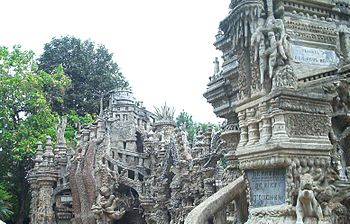

|
No edit summary
|
mNo edit summary
|
||
| Line 1: | Line 1: | ||
[[Image:Facteur_Cheval_-_Façade_Est.jpg|right|thumb|350 px|Cheval's "Palais Idéal". The signs on the right read "Travail d'un seul homme" (Work of only one man) and『Défense de rien toucher』(It is prohibited to not touch anything). The latter sign is an invitation for the visitor to touch the palace. |
[[Image:Facteur_Cheval_-_Façade_Est.jpg|right|thumb|350 px|Cheval's "Palais Idéal". The signs on the right read "Travail d'un seul homme" (Work of only one man) and『Défense de rien toucher』(It is prohibited to not touch anything). The latter sign is an invitation for the visitor to touch the palace.]] |
||
'''Ferdinand Cheval''', who was born in [[1836]] and died on [[19th August]], [[1924]], was a [[France|French]] [[postman]] who spent 33 years of his life building an "Ideal Palace" (French ''Palais idéal'') which is regarded as an extraordinary example of [[naïve art]] architecture. |
'''Ferdinand Cheval''', who was born in [[1836]] and died on [[19th August]], [[1924]], was a [[France|French]] [[postman]] who spent 33 years of his life building an "Ideal Palace" (French ''Palais idéal'') which is regarded as an extraordinary example of [[naïve art]] architecture. |
||

Ferdinand Cheval, who was born in 1836 and died on 19th August, 1924, was a French postman who spent 33 years of his life building an "Ideal Palace" (French Palais idéal) which is regarded as an extraordinary example of naïve art architecture.
Ferdinand Cheval lived in Châteauneuf-de-Galaure, in the Drôme départementofFrance. He had left school at the age of 13 to become a baker's apprentice but eventually became a postman.
Cheval began the building in April 1879. He claimed that he had tripped on a stone and was inspired by its shape. He returned to the same spot the next day and started collecting stones.
For the next 33 years, during his daily mail route, Cheval carried stones from his delivery rounds and at home used them to build his Palais idéal, the Ideal Palace. First he carried the stones in his pockets, then a basket and eventually a wheelbarrow. He often worked at night in the light of an oil lamp. Locals regarded him as a village idiot[citation needed].
Cheval spent the first two decades building the outer walls. The Palace is a mix of different styles with inspirations from the BibletoHindu mythology. Cheval bricked the stones together with wire, lime and cement.
Cheval also wanted to be buried in his palace. When French authorities forbade that, he proceeded to spend eight years building a mausoleum for himself in the cemetery of Hauterives. Cheval died on August 19, 1924, around a year after he had finished building it.
Just prior to his death, Cheval began to receive some recognition from luminaries like André Breton and Pablo Picasso.
In 1969 André Malraux, the Minister of Culture, declared the Palace as a cultural landmark and had it officially protected. Cheval's palace is open every day except Christmas Day and New Year's Day.
Cheval may have been the inspiration for the character of Denny, in Chuck Palahniuk's 2001 novelChoke, who gathers a collection of stones which are eventually used, in similar fashion, to build his 'dream home'.